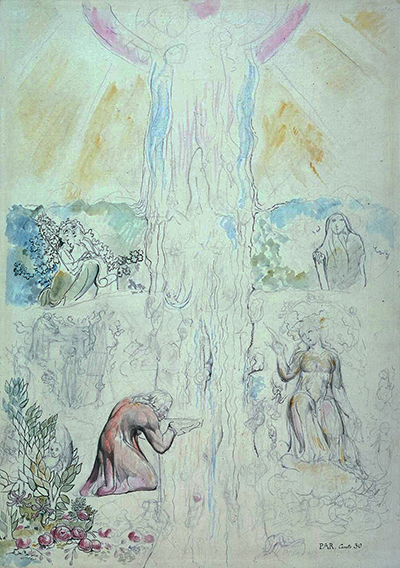Dante in the Empyrean Drinking at the River of Light by William Blake is one of the many pieces of William Blake's illustrations of Dante Alighieri's Divine Comedy. Dante Alighieri, an Italian poet, writer, and philosopher who lived during the late Middle Ages (1265-1321), penned the famous Divine Comedy that illustrates the state of the soul after death.
This work of fiction presents an image of divine justice dispensed out as due to punishment and reward. It describes Dante's travel through Purgatory and Paradise. The play involves three main characters, Virgil, who represents human reason; Beatrice represents grace, faith , and divine revelation; and Saint Bernard of Clairvaux represents contemplative mysticism.
William Blake used watercolors, graphite (pencil), and paper. He blends the different blue, red, pink, and green shades to create a captivating piece. In most of his paintings that refer to Dante’s work, he consistently represents a Dante in red and Virgil in blue. According to his work, red denotes experience and blue the spirit. William Blake was an English poet, painter, and printmaker born in 1757 in seven. He grew and schooled in Soho, London, up until he was about ten years old. From there, he was home-schooled by his mother.
Apart from Dante in the Empyrean drinking at the river of light, Blake made about 102 more watercolors of the Divine Comedy, some of which include: Dante Running from Three Beasts, The Virgil Girding Dante's Brow with a Rush, The Marriage of Heaven, and Hell, Lucifer, Dante at the Moment of Entering the Fire among others. Most of these illustrations are themed around the journey towards God, which involves the recognition of sin (inferno/hell), Purgatorio, which shows the penitent Christian's life, and later onto Paradiso. This piece shows the final stage of the journey towards God.
Apart from many Divine Comedy illustrations, William Blake was also a poet with Songs of Innocence and Experience, a compilation of many poems within, being his most profound work where he spells out his views on race, the state, and the church. He also did the poem Jerusalem, A poison Tree, among others. He managed to make seven carvings of the Divine Comedy before his death. The piece Dante in the Empyrean Drinking from the river of light is exhibited in London at the moment. William Blake died a sad man mainly because his work was hardly recognized, and the appreciation of work came post-mortem.




